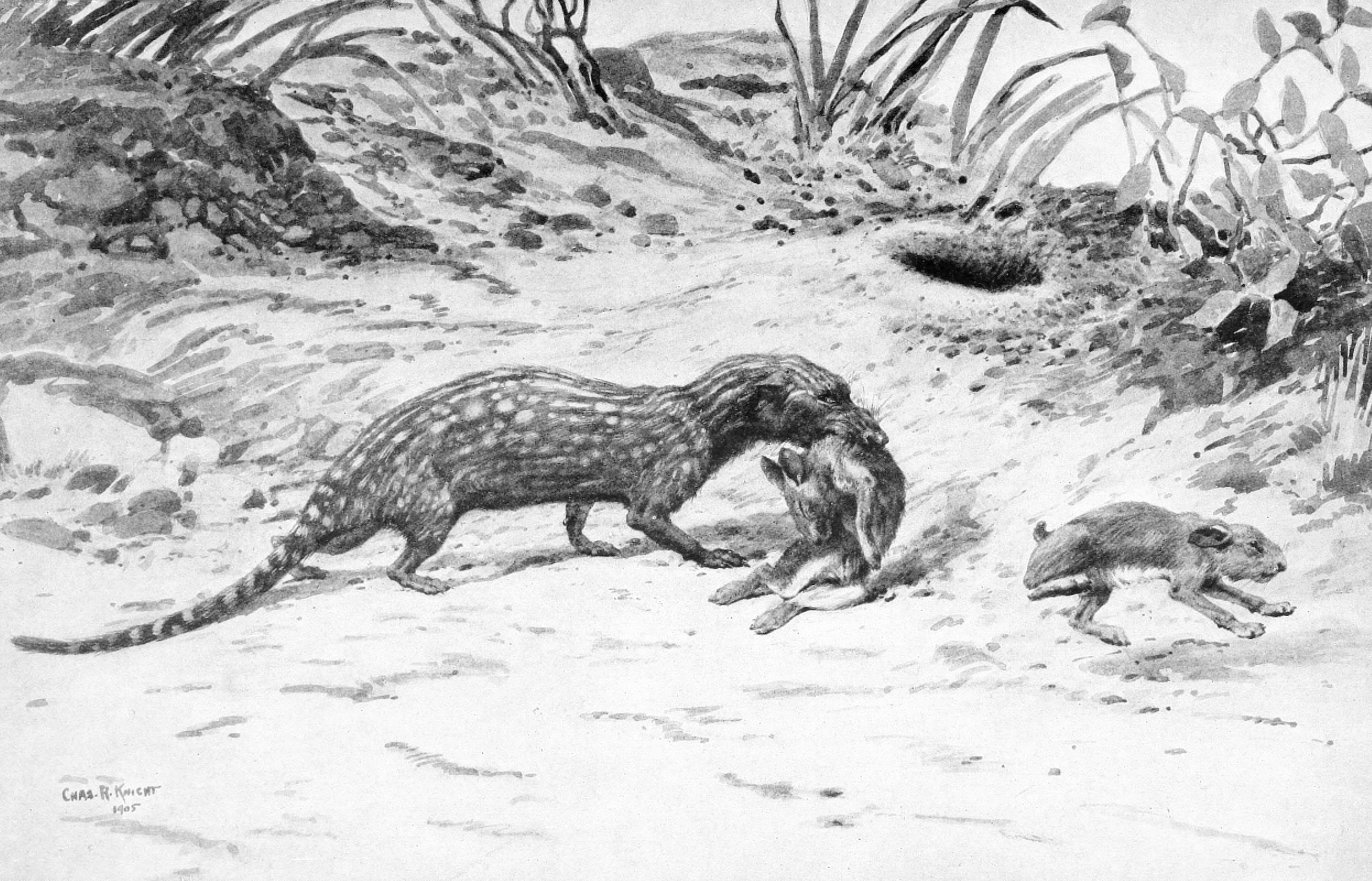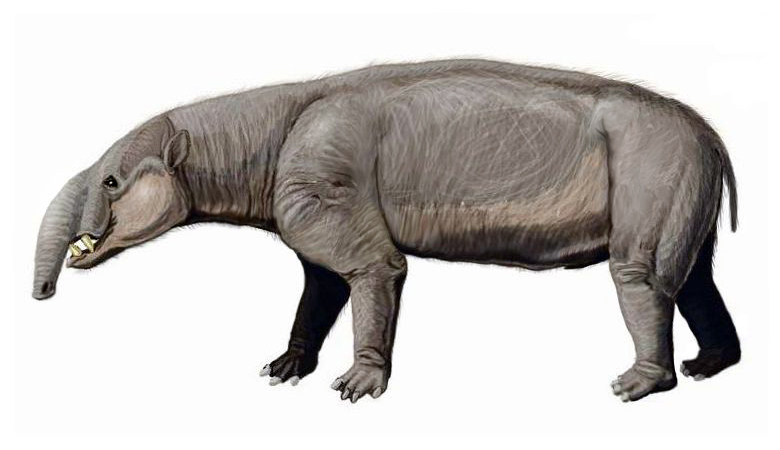|
Pachyrukhos
''Pachyrukhos'' is an extinct genus of hegetotheriid notoungulate from the Early to Middle Miocene ( Colhuehuapian- Friasian in the SALMA classification) of Argentina and Chile. Fossils of this genus have been found in the Collón Curá, Sarmiento and Santa Cruz Formations of Argentina and the Río Frías Formation of Chile.''Pachyrukhos'' at .org Description  It was about long and closely resembled a
It was about long and closely resembled a
|
Santa Cruz Formation
The Santa Cruz Formation is a geological formation in the Magallanes Basin, Magallanes/Austral Basin in southern Patagonia in Argentina and adjacent areas of Chile. It dates to the late Early Miocene epoch, and is contemporaneous with the eponymous Santacrucian age of the SALMA (South American land mammal age) timescale. The Santa Cruz Formation is known for its abundance of vertebrate fossils, including South American native ungulates (Astrapotheria, astrapotheres, Litopterna, litopterns, Notoungulata, notoungulates), as well as rodents, xenarthrans (armadillos, sloths, anteaters), and metatherians. The formation extends from the Andes to the Atlantic coast. In its coastal section it is divided into two members, the lower, fossil rich Estancia La Costa Member, which consists predominately of tuffaceous deposits and fine grained mudrock, and the upper fossil-poor Estancia La Angelina Member, which consists of sedimentary rock, primarily mudrock, and sandstone. The environment of ... [...More Info...] [...Related Items...] OR: [Wikipedia] [Google] [Baidu] |
Río Frías Formation
Río Frías Formation () is a Miocene, Middle Miocene geologic formation made up sedimentary rock located in Aysén Region, western Patagonia. The formation crops out along the upper course of Cisnes River ().Marshall & Salinas, 1990 Marsupial fossils have been found in the formation.Marshall, 1990 The Friasian period in the South American Land Mammal Ages is named after the formation. Description Río Frías Formation was discovered by Santiago Roth in the summer of 1897–98. Roth was a Swiss immigrant who had been sent to survey the area by Francisco Moreno. Moreno was director of La Plata Museum and was involved in the Cordillera of the Andes Boundary Case 1902 (Argentina, Chile), Cordillera of the Andes Boundary Case between Chile and Argentina, thus there was both a political and scientific motivation behind the exploration of Patagonia. Santiago Roth called the upper course of Río Cisnes for Río Frías being unaware that it was the same river. Further he thought this une ... [...More Info...] [...Related Items...] OR: [Wikipedia] [Google] [Baidu] |
Friasian
The Friasian age is a period of geologic time (16.3–15.5 Ma) within the Early Miocene epoch of the Neogene, used more specifically within the SALMA classification of South America. It follows the Santacrucian and precedes the Colloncuran age. Etymology The age is named after the Río Frías Formation in the Aysén Basin, Patagonia, Chile Chile, officially the Republic of Chile, is a country in western South America. It is the southernmost country in the world and the closest to Antarctica, stretching along a narrow strip of land between the Andes, Andes Mountains and the Paci .... Formations Fossils References Bibliography ;Río Frías Formation * * * * * ;Castilletes Formation * * * * * * * * ;Cerdas Beds * ;Chilcatay Formation * * * * ;Cura-Mallín Group * * * ;Gran Bajo del Gualicho Formation * ;Parángula Formation * ;Pebas Formation * * ;Río Foyel Formation * * ;Río Yuca Formation * {{SALMA Miocene S ... [...More Info...] [...Related Items...] OR: [Wikipedia] [Google] [Baidu] |
Santacrucian
The Santacrucian age is a period of geologic time (17.5 – 16.3 Mya (unit), Ma) within the Early Miocene epoch of the Neogene, used more specifically with South American land mammal age, SALMA classification in South America. It follows the Colhuehuapian and precedes the Friasian age. Etymology The age is named after the Santa Cruz Formation in the Magallanes Basin, Austral/Magallanes Basin of southern Patagonia, Argentina and Chile. Formations Fossils References Bibliography ;Santa Cruz Formation * * * * * * * * * * * * * * * * ;Aisol Formation * * ;Cantaure Formation * ;Castillo Formation * * * * * ;Cerro Boleadores Formation * ;Chaguaramas Formation * ;Chilcatay Formation * * * * ;Cura-Mallín Group * * * ;Gran Bajo del Gualicho Formation * ;Jimol Formation * * * * * * * * ;Mariño Formation * * * * * ;Pinturas Formation * * ;Río Yuca Formation * {{SALMA Santacrucian, Miocene South America ... [...More Info...] [...Related Items...] OR: [Wikipedia] [Google] [Baidu] |
Colhuehuapian
The Colhuehuapian age is a period of geologic time (21.0–17.5 Ma) within the Early Miocene epoch of the Neogene, used more specifically within the SALMA classification in South America. It follows the Deseadan and precedes the Santacrucian age. Etymology The age is named after the Colhué Huapí Member of the Sarmiento Formation in the Golfo San Jorge Basin, Patagonia, Argentina Argentina, officially the Argentine Republic, is a country in the southern half of South America. It covers an area of , making it the List of South American countries by area, second-largest country in South America after Brazil, the fourt .... Formations Fossils References Bibliography ;Colhué Huapí Member * * ;Abanico Formation * * * * * * ;Biblián Formation * ;Castillo Formation * * * * * ;Cerro Bandera Formation * * ;Chichinales Formation * * ;Chilcatay Formation * * * * * * * * * * ;Cura-Mallín Group * * * ;Gaiman Formati ... [...More Info...] [...Related Items...] OR: [Wikipedia] [Google] [Baidu] |
Notoungulata
Notoungulata is an extinct order of ungulates that inhabited South America from the early Paleocene to the end of the Pleistocene, living from approximately 61 million to 11,000 years ago. Notoungulates were morphologically diverse, with forms resembling animals as disparate as rabbits and rhinoceroses. Notoungulata are the largest group of South American native ungulates, with over 150 genera in 14 families having been described, divided into two major subgroupings, Typotheria and Toxodontia. Notoungulates first diversified during the Eocene. Their diversity declined from the late Neogene onwards, with only the large Toxodontidae, toxodontids persisting until the end of the Pleistocene (with ''Mixotoxodon'' expanding into Central America and southern North America), perishing as part of the Late Pleistocene extinctions, Late Pleistocene megafauna extinctions along with most other large mammals across the Americas. Collagen sequence analysis suggests that notoungulates are closely ... [...More Info...] [...Related Items...] OR: [Wikipedia] [Google] [Baidu] |
Sarmiento Formation
The Sarmiento Formation (Spanish language, Spanish: ''Formación Sarmiento''), in older literature described as the Casamayor Formation, is a geological formation in Chubut Province, Argentina, in central Patagonia, which spans around 30 million years from the mid-Eocene to the early Miocene. It predominantly consists of Pyroclastic rock, pyroclastic deposits, which were deposited in a Semi-arid climate, semi-arid environment. It is divided up into a number of members. The diverse fauna of the Sarmiento Formation, including a variety of birds, crocodilians, turtles and snakes, also includes many mammals such as South American native ungulates (notoungulata, notoungulates, litopterna, litopterns, astrapotheria, astrapotheres) as well as armadillos, and Caviomorpha, caviomorph rodents. Material was copied from this source, which is available under a creativecommons:by/3.0/, Creative Commons Attribution 3.0 International License Paleofauna Amphibians Birds Reptiles Crocodylom ... [...More Info...] [...Related Items...] OR: [Wikipedia] [Google] [Baidu] |
Hegetotheriidae
Hegetotheriidae is an extinct family of notoungulate mammals known from the Oligocene through the Pliocene of South America South America is a continent entirely in the Western Hemisphere and mostly in the Southern Hemisphere, with a considerably smaller portion in the Northern Hemisphere. It can also be described as the southern Subregion#Americas, subregion o .... References Typotheres Oligocene mammals Miocene mammals of South America Pliocene mammals Pliocene extinctions Pliocene notoungulates Prehistoric mammal families {{notoungulate-stub ... [...More Info...] [...Related Items...] OR: [Wikipedia] [Google] [Baidu] |
Collón Curá Formation
The Collón Curá Formation () is a Middle Miocene fossiliferous geological formation of the southern Neuquén Basin in northwestern Patagonia and the western Cañadón Asfalto Basin of central Patagonia, Argentina. The formation crops out from the southern Neuquén Province, the western Río Negro Province to the northern Chubut Province. The formation, with a maximum thickness of , comprises tuffs and sandstones with minor siltstones, marls and limestones, deposited in a fluvial, deltaic and shallow to deep lacustrine environment in small basins separated by faults. The formation dates from the Langhian to earliest Tortonian epochs of the Middle to Late Miocene, typically Colloncuran. The Collón Curá Formation is named after Estancia Collón Curá (1 on the map in the infobox) along the Collón Curá River (2), a tributary of the Limay River in the Río Negro watershed, and lends its name to the Colloncuran, one of the South American land mammal ages. Th ... [...More Info...] [...Related Items...] OR: [Wikipedia] [Google] [Baidu] |
Miocene
The Miocene ( ) is the first epoch (geology), geological epoch of the Neogene Period and extends from about (Ma). The Miocene was named by Scottish geologist Charles Lyell; the name comes from the Greek words (', "less") and (', "new") and means "less recent" because it has 18% fewer modern marine invertebrates than the Pliocene has. The Miocene followed the Oligocene and preceded the Pliocene. As Earth went from the Oligocene through the Miocene and into the Pliocene, the climate slowly cooled towards a series of ice ages. The Miocene boundaries are not marked by distinct global events but by regionally defined transitions from the warmer Oligocene to the cooler Pliocene Epoch. During the Early Miocene, Afro-Arabia collided with Eurasia, severing the connection between the Mediterranean and Indian Oceans, and allowing the interchange of fauna between Eurasia and Africa, including the dispersal of proboscideans and Ape, hominoids into Eurasia. During the late Miocene, the conn ... [...More Info...] [...Related Items...] OR: [Wikipedia] [Google] [Baidu] |
Neogene Argentina
The Neogene ( ,) is a geologic period and system that spans 20.45 million years from the end of the Paleogene Period million years ago ( Mya) to the beginning of the present Quaternary Period million years ago. It is the second period of the Cenozoic and the eleventh period of the Phanerozoic. The Neogene is sub-divided into two epochs, the earlier Miocene and the later Pliocene. Some geologists assert that the Neogene cannot be clearly delineated from the modern geological period, the Quaternary. The term "Neogene" was coined in 1853 by the Austrian palaeontologist Moritz Hörnes (1815–1868). The earlier term Tertiary Period was used to define the span of time now covered by Paleogene and Neogene and, despite no longer being recognized as a formal stratigraphic term, "Tertiary" still sometimes remains in informal use. During this period, mammals and birds continued to evolve into modern forms, while other groups of life remained relatively unchanged. The first humans ('' ... [...More Info...] [...Related Items...] OR: [Wikipedia] [Google] [Baidu] |



